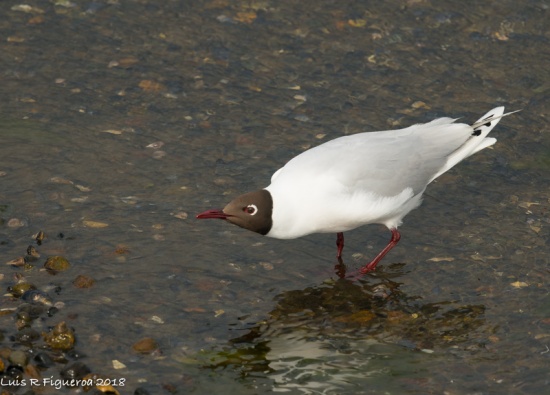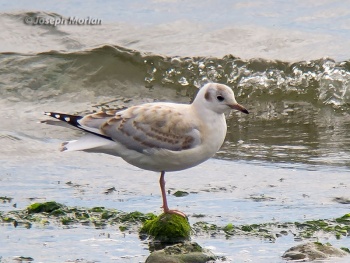- Chroicocephalus maculipennis
Larus maculipennis
Identification
35–37 cm (13¾-14½ in)
Breeding adult
- Grey upperparts
- White underparts
- Brown hood
- White eye crescents
- White nape, neck and breast
- Grey-white wings
- Deep red bill and legs
Non-breeding adult
- White head
- Dark spots behind the eye
Juvenile
- Mottled brown head, back and wings.
- Wings with narrow black trailing edge
- Tail with narrow, black subterminal bar
- Bill pinkish with black tip
- Pinkish-brown legs and feet
Similar Species
They bear a strong resemblance to the Black-headed Gull but Brown-hooded Gull has a slightly darker mantle, narrower dark subterminal band on its primaries, more dark at the bases of its outermost primaries, and usually distinct white primary tips cf. Black-headed.
Distribution
Southern South America : found in Ecuador, Bolivia, Brazil, Paraguay, Uruguay, Chile, Argentina and the Falkland Islands.
Taxonomy
Sometimes treated as a subspecies of the similar Black-headed Gull and sometimes placed in the genus Larus.
Subspecies
Usually treated as monotypic[1] but some authors classify birds from northern Argentina to southern Brazil as the nominate race while C. m. glaucodes with more white in its wing-tips is found throughout the rest of the bird's range[6].
Habitat
Sea coasts, rivers, lakes and marshes; in winter also frequents sewage outfalls and slaughterhouses.
Behaviour
Actions
Catches prey directly from the water's surface, often around kelp beds. Also forages along the shore, as well as at sea, lakes, ponds and marshes.
Breeding
Sometimes solitary but they usually nest in colonies of 10-50 pairs, occasionally up to 500 nests. Colony locations often change from year to year according to food resources and nest site availability. The nest may be a floating platform of aquatic vegetation, a bulky grass structure on dry ground, or in a hollow lined with vegetation. Nests are often located in aquatic vegetation around edges of lakes, ponds or marshes, or sometimes on shingle beaches or rocky headlands, or in remote coastal plains. The clutch consists of 2 to 4 olive-brown eggs with rufous and greyish markings.
Diet
Includes small fish and marine invertebrates such as mollusks and crustaceans, earthworms and insects. They also eat carrion and offal when available. In cultivated areas they may follow the plow where they feed on numerous invertebrates, including Lepidoptera and parasitic insects. Like most gulls, they also may steal food from other bird species.
Movements
Relatively sedentary, dispersing to large rivers and coastal areas after breeding when some move north to Northern Chile and Eastern Brazil
Vocalisations
Calls include harsh croaking and screaming notes sometimes accompanying ritual displays.
References
- Clements, J. F., T. S. Schulenberg, M. J. Iliff, D. Roberson, T. A. Fredericks, B. L. Sullivan, and C. L. Wood. 2018. The eBird/Clements checklist of birds of the world: v2018. Downloaded from http://www.birds.cornell.edu/clementschecklist/download/
- Avibase
- Arthur Grosset
- Birds of the Falkland Islands
- Jaramillo, A. 2003. Birds of Chile. Princeton & Oxford: Princeton Univ. Press. ISBN 978-0691117409
- Howell, S.N.G. & Dunn, J.L. (2007) Gulls of the Americas. Houghton Mifflin, Boston.
- Burger, J., Gochfeld, M. & Garcia, E.F.J. (2019). Brown-hooded Gull (Larus maculipennis). In: del Hoyo, J., Elliott, A., Sargatal, J., Christie, D.A. & de Juana, E. (eds.). Handbook of the Birds of the World Alive. Lynx Edicions, Barcelona. (retrieved from https://www.hbw.com/node/53994 on 22 January 2019).
- Brown-hooded Gull (Chroicocephalus maculipennis), In Neotropical Birds Online (T. S. Schulenberg, Editor). Cornell Lab of Ornithology, Ithaca, NY, USA. retrieved from Neotropical Birds Online: https://neotropical.birds.cornell.edu/Species-Account/nb/species/brhgul2
Recommended Citation
- BirdForum Opus contributors. (2025) Brown-hooded Gull. In: BirdForum, the forum for wild birds and birding. Retrieved 9 May 2025 from https://www.birdforum.net/opus/Brown-hooded_Gull
External Links
GSearch checked for 2020 platform.1







